Follow these 10 strategies to reduce cart abandonment and 1 strategy to recover lost sales post cart abandonment
Your customers add items to their carts, they may even start the checkout process, but then they leave the site and abandon the items.
Sounds familiar?
This is the cart abandonment phenomenon.
Cart abandonment is a common phenomenon in e-commerce, with an average cart abandonment rate of 68.63% for 2016 (see chart below).
Online shopping cart abandonment rate worldwide from 2006 to 2017, Statista.
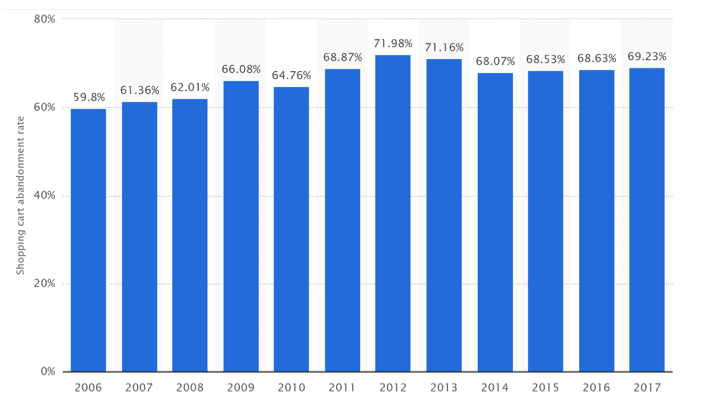
There are many reasons for customers to abandon their carts. Some of the most common reasons can be seen in the chart below.
Primary Reasons for Cart Abandonment in the U.S. in Q4 2016, Statista
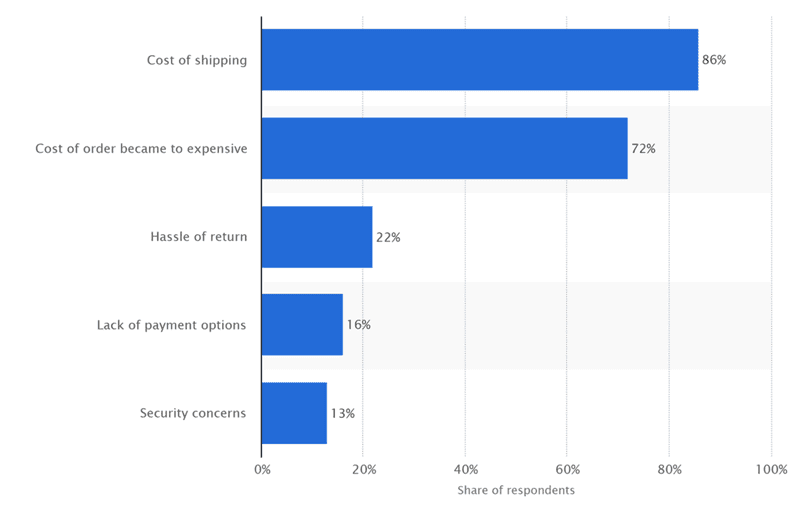
So why is cart abandonment a major issue for ecommerce sites?
Think of the amount of resources that are used up to get a shopper to enter your site and get excited about an item so much to put it in their cart. Then if they leave, you have to spend more resources to get them back to your site.
But if you just adjust something on your site, often it’s very simple and effortful, you can prevent spending all of those extra resources.
Furthermore, if that customer doesn’t return to your site and finalizes the purchase, the abandoned items are potential revenue that you have lost. And it adds up to be approximately $18 billion lost revenue per year, according to CPC Strategy.
What can you do?
To help you out, this article will cover 10 ways you can reduce cart abandonment and 1 way to combat cart abandonment after it occurs. We will cover the issue each strategy prevents and how to implement it.
1. Provide Free Shipping
According to Statista, the cost of shipping is the top reason for cart abandonment.
Customers become irritated if they start the checkout process and suddenly see that the total cost is higher, especially if it is very high. Transparency is crucial, so when shoppers tackle previously-hidden shipping costs they feel fooled.
This reduces their satisfaction and trust in the company, resulting in cart abandonment.
To prevent this issue, offer your customers a form free shipping and disclose it at the very beginning of their journey. This way you sell your products with no additional cost and disclose the total cost at the very beginning.
You can experiment with the way you offer free shipping to see which results in the most conversions for your company. Some options are:
- Nationwide/worldwide
- Selected products/categories
- At a minimum order value
- For a limited time frame
- For first time/returning customers
- For cart abandoners in remarketing emails
For example, BetterWorldBooks offers free shipping worldwide.

ThinkGeek offers free shipping at a minimum value of $75 to encourage a higher order value. A purchase with a lower order value will pay a flat rate of $7.95. This shipping policy is disclosed in the beginning using the top banner, which enhances the shopper’s trust in the company.

Prettylittlething offers free shipping for purchases made within 3 hours of entering the site and a next day delivery at an extremely low cost for purchases made by the end of the day. Both options utilize a sense of urgency to encourage fast purchasing.

2. Offer Express Shipping
Some shoppers need a certain product immediately.
If it cannot be delivered by the date they require it, it is of no use to them. Therefore, when a customer starts the checkout process and realizes there is no shipping option quick enough for her desired date, the customer will abandon the cart.
This cart abandonment issue can be easily avoided by offering express shipping and/or next day delivery.
The way in which ASOS offers free shipping is insufficient. There are only two options and there is no indication of how fast the express delivery is. The full explanation may be in the FAQ page, but a shopper may not bother to check it and leave instead.
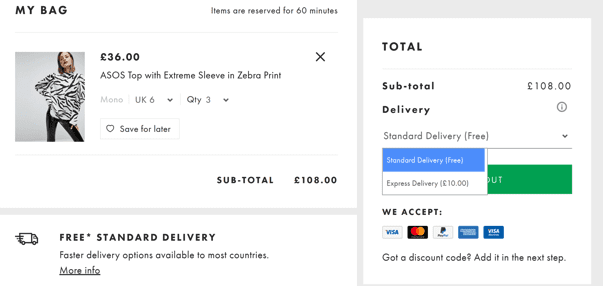
On the other hand boohoo is a stellar example. There are 4 options of shipping within the U.S. and each option has its price and expected number of delivery days. This way a shopper can make an informative decision.

3. Offer Guest Checkout
Needing to create a new user account irritates some shoppers because it elongates the checkout process and without giving shoppers a choice.
Shoppers who seek immediacy can see it as such a nuisance having to put time and effort to complete the transaction that they abandon their carts.
This is easily fixable by offering a guest checkout option. If the shopper chooses this option, offer them to make a new user account after the transaction is made.
You should give your customers a choice, so the guest checkout option should be on top of the option to login, create a new user account and more.
An example of a clear and efficient strategy is dotti. Not only does dotti provide a guest checkout option but it also assures to shoppers that it won’t require creating an account.
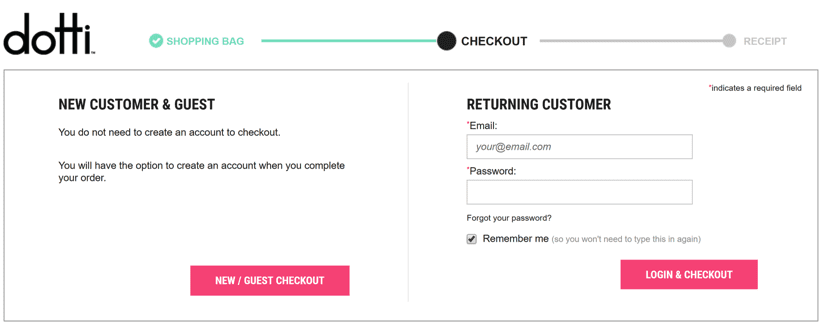
4. Make Your Checkout Process Clearer
A confusing checkout process can also result in cart abandonment.
If shoppers don’t understand where they need to click or why they need to fill something in, they might just leave the site. Customers don’t want to put much effort into making the transaction.
According to Baymard this is a major issue as 1 in 4 shoppers abandoned their cart because of a long or complicated checkout process.
How can you clarify your checkout process?
- Have clear calls to action (clarifying the next action, where they’ll get to).
- Explain why each form element needs to be filled out.
- Have a back button to the site (otherwise might leave the website altogether)
- Have an edit button for the product (otherwise might leave the website)
ASOS shows how this can be done properly. The checkout has 4 steps. Each one is short and has one, clear CTA to continue to the next step. Once the CTA is clicked on the next step is automatically revealed, with the final CTA being the “place order” button.
This approach allows a clear and flowing checkout. Furthermore, the customer can edit their cart or go back to the website all throughout the process.
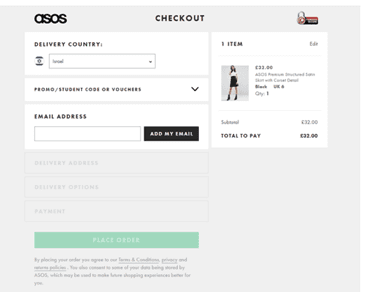
5. Auto-Apply Coupons
If a customer sees a coupon field in the checkout, they most often get the feeling that they’ll be paying too much without a discount.
So, they begin to search for a code on the site or codes they’ve received via email. Once they start looking for it, they often don’t return to the site - either because of diversions or because they wait until they are offered a discount.
Alternatively, if they haven’t been offered a code they might decide to wait for one.
This issue can be easily solved by eliminating coupon code bars in the checkout and auto-applying coupon codes for shoppers that are offered a discount (via email or popup), see the example below.
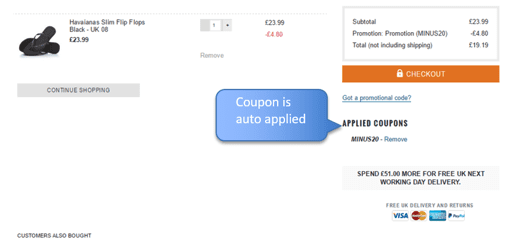
Another option is to have a set banner with the coupon code which the customer can see on the checkout page as well, as boohoo does.
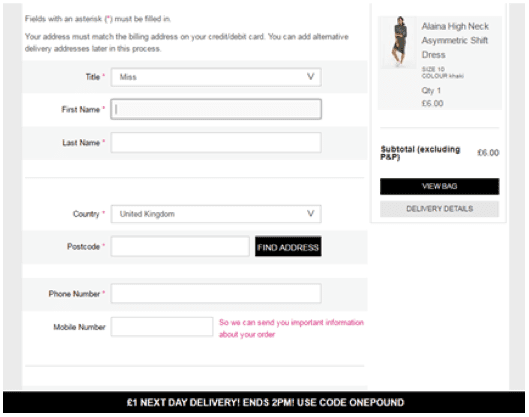
If the shopper isn’t offered a discount, make the coupon bar less noticeable and farther away from the checkout.
6. Include Security Symbols
Concerns about payment security (i.e. stolen identities or credit card information, incorrect charging of the card, etc.) is one of the main reasons for cart abandonment.
If the shopper doesn’t fully trust the company she’ll most likely abandon her cart.
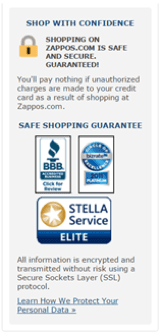 To earn the shopper’s trust and ensure credibility, include:
To earn the shopper’s trust and ensure credibility, include:
- SSL certificates.
- Trust seals (logos) - without one, 61% of shoppers will not make a purchase (Actual Insights).
- Logos of other known companies who cooperate with the site.
- Reviews and testimonials of customers who have made a purchase
Zappos displays security logos on each page of the checkout process to reiterate safety. If a customer clicks on “more information” they can read about SSL technology, VeriSign cooperation, firewalls and more. There are also numerous customer reviews.
7. Provide a Live Chat Option
Your shoppers may have questions or issues about technicalities (the product, shipping, returns, etc.) or may be hesitant about their shopping decision.
If the shopper does not have who to contact for these issues they might leave. If the shopper contacts the company via emails or social media the replies might take too long and may be intermittent, which is likely to result in cart abandonment as well.
Live chat prevents all of that.
With live chat your sales representatives can provide immediate, flowing and ongoing customer service, to ensure all doubts and issues are removed. Hence, this type of customer service is more effective in keeping the customer on-site and satisfied.
Furthermore, the nature of the replies in live chat is similar to the nature of face-to-face communication in-store, which is more approachable and provides intimacy and personal interaction.
Indeed, a study by LivePerson found that 51% of online shoppers are more likely to make a purchase if they have live chat support.
SimplyBe is a great example. The customer only needs fill in their name, email and question. The reply is extremely quick (my reply was within two minutes) and is extremely personal (using the salesperson’s name and approachable tone).

8. Inject Customer Input
Other shoppers’ opinions have a great influence over the individual’s opinion because of their objectivity to the company. There are perceived as a reliable and unbiased source as they have nothing to gain from advocating for the company.
Therefore, social proof is a great way to help customers who are hesitant (about the product, shipping, security, etc.) to make up their minds.
Create social proof by injecting as much customer added information as possible and encouraging customers to add their inputs. Such information includes:
- Reviews
- Testimonials
- Ratings
- Customers’ photos with the product
French Connection is an excellent example for providing customer input (and having much of it). On the product page, the customer can see each person’s review and rating as well as the date it was posted in a clear manner.

Boohoo sets a great example for providing and encouraging visual customer input:
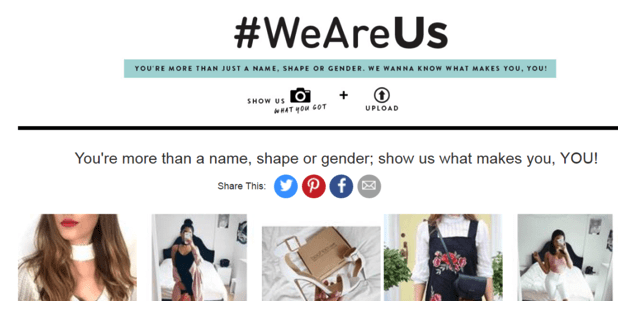
9. Improve Your Return Policy
The third reason for cart abandonment is the hassle of return. Meaning, returning unwanted products is complex, costly, short in time, etc.
But, if shoppers are able to return the product for free and have a long time period in which they can return it, the negative consequences of ending up not wanting the product are removed.
Cpcstrategy found that 2 out of 3 shoppers would buy more online if returns were free.
Having higher flexibility in the return of products can motivate hesitant shoppers to make a purchase, knowing they can easily and without cost return items if they end up not wanting them.
So make your return policy include:
- Many days to return (ideally 30 days or more)
- Free returns
- late/wrong delivery will receive compensation (financial or product wise)
- A comprehensive return policy information on the site to eliminate any speculations
Zappos is known for being the star of return policies.
First, it provides extensive return information on the FAQ page:
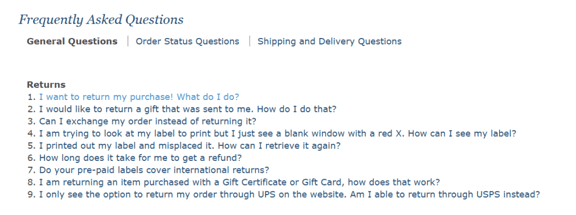
Second, its return policy is extremely favorable and risk-free - allowing a cost-free return for a year from the purchase date.

10. Provide a Wide Variety of Payment Methods
If shoppers cannot pay with their preferred payment method they most likely will abandon their carts. According to ClickandBuy this number stands at 50% of shoppers.
So, provide the widest variety of payment methods to prevent this cart abandonment reason from prevailing. Some of the common payment methods you must include are:
- Visa
- MasterCard
- Discover
- American Express
- PayPal
- Local payment methods. For example AliPay in China.
Aliexpress offers a very wide variety of payment methods. It accepts all of the following:

And... 1 Way to Recover Up to 30% of Your Abandoned Carts:
The previous 10 changes will reduce your cart abandonment rate, but unfortunately, cart abandonment cannot be eliminated completely.
Worry not - we have a strategy for post-abandonment!
It is the multi-stage email remarketing campaign.
This includes a series of triggered emails that are personalized and generated in real-time. The emails may contain the abandoned cart contents, product recommendations, monetary incentives and more.
The emails allow you to re-engage and interact with your customers, building a relationship with them.
They efficiently motivate your abandoners to return to the site and recover their carts - proven to reduce cart abandonment by 10%-30% and induce an average of 18% conversion rate.
After implementing a cart abandonment software, SurfStitch achieved a 300% revenue lift and more than doubled their ROI. The cart abandonment emails (see one below) had a 300% increase in conversion rate and 50% increase in click-through-rate.
Learn about this campaign’s best practices, to maximize its effectiveness and recover as many carts as possible.
Final Thoughts
This list offers solutions that are relatively easy and quick to implement and can greatly reduce your cart abandonment rate.
We recommend you first investigate which of the issues discussed are most detrimental for your company, as each company has different weak spots. According to that, determine which of these strategies is most urgent for you to implement and start with it.
In this manner, tackle your cart abandonment reasons one by one from the most crucial to the one with the smallest effect.
At the same time, implement a cart abandonment emails software for recovering lost sales, as not all cart abandonments can be prevented.
Lastly, always remember to track your cart abandonment rate when you implement these changes, to monitor your success.
Thanks to Guy Cizner for sharing his advice and opinions in this post. Guy Cizner is an inbound marketing manager and a conversion optimization specialist for the last 10 years. I am part of an amazing team at
Barilliance. We provide tools for eCommerce personalization with the goal of improving website conversion rates.
You can get in touch with me on on
LinkedIn or follow us on
Twitter.

























